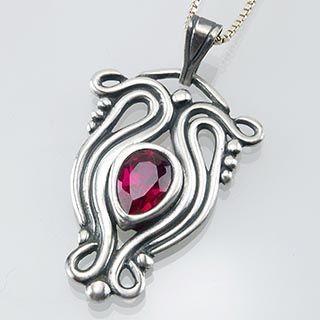Differences Between Silver and Base Metal Clays
As people begin exploring and working with metal clay, they often ask the question, “What is the difference between silver clay and base metal clay?”
The answer to this question requires a basic understanding of what metal clay is and how it is formulated.
Metal clays consist of powdered metal, powdered binders and water.
- The water evaporates as pieces dry, resulting in a small amount of shrinkage.
- During the first stage of firing, the binder is burned off.
- During the rest of the firing, the metal particles bond together, a process called sintering.
The various formulas and types of metal clays can require different firing techniques and schedules, and can result in varied shrinkage of the final product. Understanding each clay’s optimal firing schedule, and knowing how much it will shrink, is important information when selecting and using a specific clay formula.
Ruby pendant, silver clay, Lis-el Crowley
Silver Clays
Fine silver clay is composed of fine silver particles with binder. There are also Sterling silver and enriched Sterling silver clays, which are made of mostly silver particles with various amounts of copper added depending on the formula. The term enriched Sterling silver refers to the fact that the formula has more than 92.5% silver in it, as traditional Sterling silver is 92.5% silver and 7.5% copper.
Pendant, bronze clay, Hadar Jacobson
Base Metal Clays
As far as base metal clays go, there are a great variety of options from several types of copper, bronze, brass and steel. Many of these clays are alloys of different powdered metals, some formulas combine the different powders to create the alloy, and some actually use a powdered form of the alloy itself. For example, bronze is usually a combination of copper and tin, brass is copper and zinc, and white copper is copper and nickel.
Some brands of metal clays create specialized colors by adding other metals to the mixes. As an example, colored irons can contain iron, brass (copper and zinc) and bronze (copper and tin). Information regarding the metals included in any particular clay formula may be obtained from the manufacturer.
Oxidation: A Key Difference Between Silver and Base Metal Clays
One of the most important factors in understanding the difference between base metal and silver clays is to understand the oxidation process which occurs during firing. When fired in the presence of oxygen, copper develops a dark oxide on the surface. This can prohibit the metal from sintering properly and is the reason base metals and some sterling clays with a higher level of copper in them require different firing techniques and schedules from fine silver clays.
FIRING
Firing with Oxygen Present: Open Shelf Firing
Fine silver clays and some of the hybrids can be fired on an open shelf in the presence of oxygen, with a relatively simple and short firing schedule. This is because there is little or no copper to be dealt with.
Firing in Carbon to Limit Oxygen Exposure
In base metal clays, to avoid oxidation of copper during firing, the oxygen must be eliminated or reduced in the kiln. The easiest way to do this is to use carbon in the firing set up. Carbon absorbs oxygen, allowing the metal to sinter properly. The most common practice is to place base metal clay pieces in a firing container filled with activated coconut carbon in a kiln. Ceramic or stainless steel containers are the most widely used.
Another consideration is that each of the metals within the clay melts at a different temperature. If the metal was alloyed prior to being powdered, it will have a melting temperature of that alloy. If the clay was made with two metals, for example copper and tin, the tin may melt before the copper starts to sinter. This issue is resolved by lower temperature and longer firing times to allow the higher temperature metal to begin to sinter while the lower temperature metal holds its shape and becomes fully sintered.
Firing with a torch and heatproof block
Steel container and carbon for kiln firing
How to Fire Successfully
- Use the manufacturer’s recommended schedule: Manufacturers of each clay formula have devoted substantial time and effort to determine the best firing schedule and technique for their formula. The manufacturer directions for firing will be based on their knowledge of the metals included in the clay. For this reason, it is recommended you begin your firing of base metal clays with the manufacturer’s recommended schedule.
- Do a test firing: Each piece of equipment is a variable which factors into the firing temperatures and times. If you change one variable, you may need to adjust for it. For example, ceramic containers fire hotter than stainless steel containers. Adjustments may need to be made for these variables. Also, kilns often fire hotter or colder than the temperature readout indicates.
For this reason, it is always recommended that a test firing for any new clay be performed. It may require a few tests to determine the optimal firing schedule for each specific clay, but it is worth the effort to achieve consistent results.
How to do a test firing
- Create a strip out of the clay that is 5 cards thick, 2 inches long and ¼ – ½ inch wide.
- After firing, bend the strip using pliers into a u shape.
- If it bends successfully, the piece is fully sintered, and the firing schedule is sufficient.
- If it melts, the schedule was too hot.
- If it breaks, there could be a few reasons. If the binder didn’t burn out completely, the initial binder burnout phase of the firing needs to be slowed. Or if the kiln fires cool, a hotter temperature or longer hold may be required.



